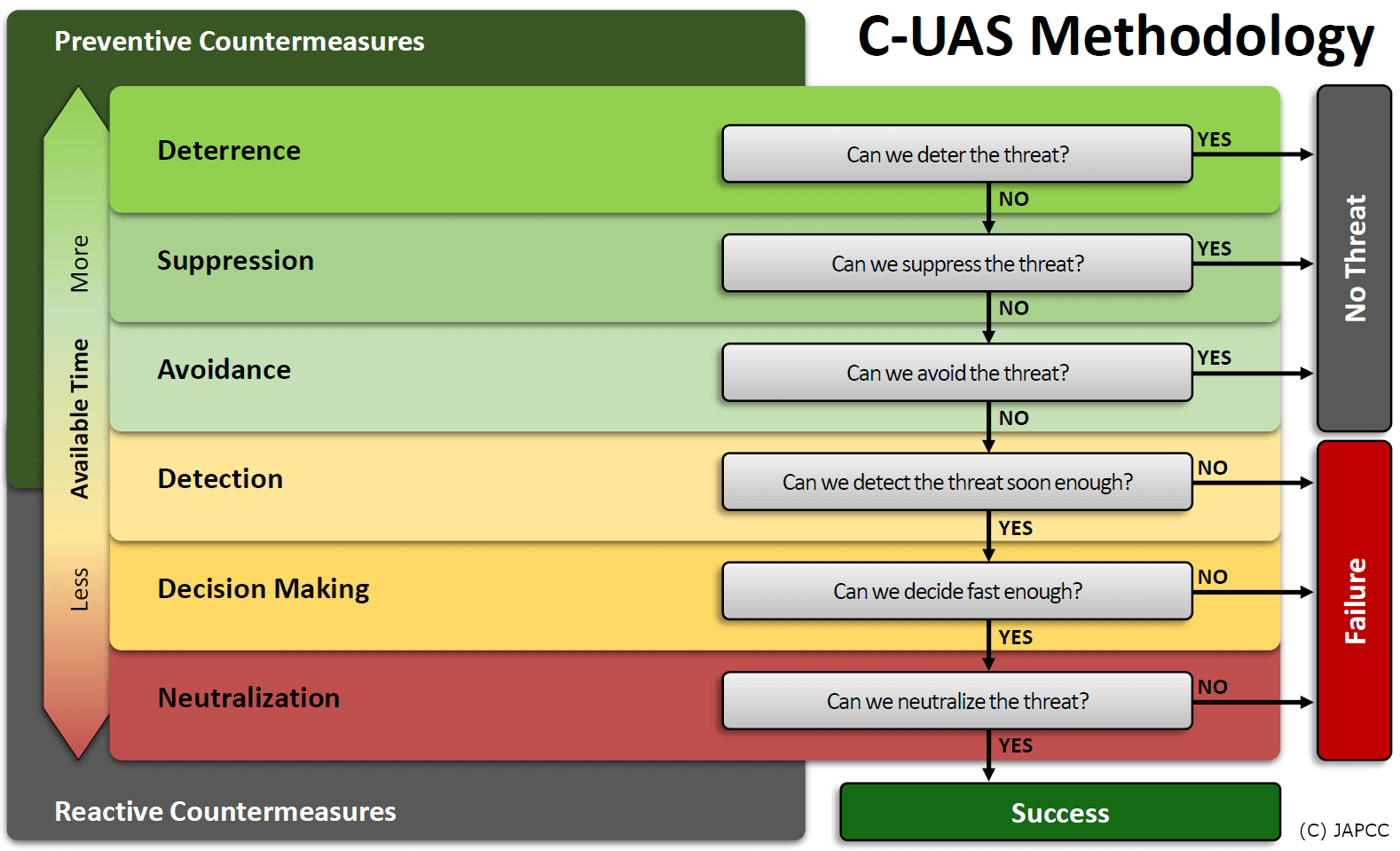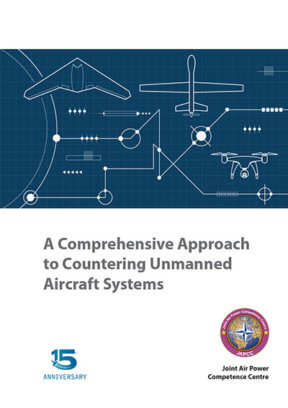Overview
The challenge of Countering Unmanned Aircraft Systems (C-UAS) has been recognized and taken seriously after incidents with commercially available drones showed that even small systems could project a viable threat to political leaders, critical infrastructure and commercial businesses. Chapter 3 (cf. p. 48 ff.) provided some examples of recent incidents and outlined them in more detail.
A multitude of C-UAS systems have since been developed to satisfy the growing need to defend against drones, especially in the low, slow, and small spectrum. In principle, these systems are designed to detect and then engage the threat, and some systems have indeed proven to be quite successful in fulfilling their mission.
However, a comprehensive C-UAS approach must not only rely on reacting to an imminent threat, but it has to include preventive measures as well. Assuming that preventive measures helped eliminate the presence of a drone in the first place, then no active countermeasure would be necessary.
This chapter provides a potential methodology which incorporates preventive as well as reactive countermeasures. The countermeasures are listed sequentially, based on the time available to employ them. The previous two pages portray that approach in general terms, whereas the subsequent sections will describe every measure in more detail.

Preventive Countermeasures
Preventive countermeasures have the advantage, if successfully applied, that a potential threat will not even occur and reactive countermeasures need not be employed. Moreover, they are not subject to time pressure, as preventive measures can be taken well in advance and thoroughly planned.
Deterrence
Successfully deterring enemy forces or civilians from using UAS or drones will negate the threat completely. For deterrence to be effective, enemy forces or civilian drone users have to anticipate such negative consequences that the mere prospect of suffering them is sufficient to refrain from using UAS or drones.
Deterring enemy forces from using UAS is undoubtedly problematic, as these systems offer significant military advantages without putting the lives of their forces at risk. However, the prospect of losing a high number of UAS to NATO air defences may be a sufficient deterrent if the adversary’s military budget is constrained or the availability of UAS is so limited that losing them is not affordable. Strategic Communications (STRATCOM) may also help spread the message that UAS employment against NATO territory or forces will be denied or come at a high cost. Consumers and commercial companies may be fined for unlawful use of their drones. This probably requires dedicated legislation, but at minimum the incorporation of unmanned flight into the national rules of the air. This may not entirely prevent drone incidents, but it may help reduce them significantly and allow the focus on actual threats.
Suppression
If enemy forces or civilians cannot be deterred from using UAS or drones, the next step would be to deny them access to NATO airspace or protected areas and prevent them from achieving their goals.
For military UAS, NATO air defences and Electronic Warfare (EW) are likely the most effective means that can successfully suppress enemy UAS operations. During open conflict, Air Interdiction (AI) and cyber-attacks against UAS ground installations and networks may prevent UAS employment right from the start. EW will also work against consumer and commercial drones; however, peacetime restrictions may limit this option significantly. Again, legislation may be an option to impose obligations for manufacturers that drones adhere to flight restrictions automatically, e.g. incorporating geofencing parameters by default.
Avoidance
If the employment of UAS or drones cannot be deterred or suppressed, the detection or effects from these systems need to be avoided.
Avoiding detection or kinetic effects from the air is not new. However, many traditional measures may not have been sufficiently trained or even forgotten in the last decade due to the war on terrorism and the actual absence of a serious air threat. Long established Tactics, Techniques, and Procedures (TTP) may have to be brought back to soldier’s minds, and, if necessary, reviewed and modified for this new type of air threat. Modern sensor technology may be countered by fielding newer materials which are capable of better absorbing or reducing radar reflections or thermal signatures. Protective measures for military installations and critical infrastructure, but also military forces in the open, may require review and modernization to shield them from detection and kinetic effects.
Reactive Countermeasures
Detection
As a prerequisite for any further countermeasures, the existence of a threat must first be identified. Detection is the first action in a series of active measures against UAS or drones, and therefore time is one of the most critical factors. In general, detection must take place at the earliest possible time and the furthest measurable distance.
Intelligence, Surveillance and Reconnaissance (ISR) is the key to detecting and identifying threats from UAS or drones. Most importantly, ISR should not be limited to the UA itself; the detection of any elements or components of an unmanned system could help to increase situational awareness of an imminent adversarial deployment of UAS. Electromagnetic Operations as part of Signal Intelligence (SIGINT) could also contribute to detecting UAS and drone threats as most systems require continuous radio transmissions to operate. Newer methods of Command and Control (C2) of UAS and drones use cellular networks, and this may require additional cyber tools to help detect this communication. In particular, the use of drones for private and commercial use may require updated regulations and data protocol disclosure to help law enforcement agencies and the military detect and identify drone operations.
Decision-Making
Defending against an imminent UAS or drone threat is the most time-critical. Due to their size and altitude, the detection of Low, Slow, and Small (LSS) drones can be expected to be generally later and the reaction time significantly shorter than for HALE and MALE UAS or fighter aircraft in general.
Established Air C2 and Time-Sensitive Targeting (TST) procedures may require a review to determine if and how to accelerate decision-making processes and probably delegate decision-making authorities to counter this new type of air threat. Countering LSS drones is probably more a question of rapid self-defence at the team or squad level than decision-making at higher echelons. This may require the general incorporation of drone countermeasures into the regular curriculum and training of each soldier. Additionally, countering UAS and drones in peacetime may require close cooperation with law enforcement agencies and the clear delineation of responsibilities.
Neutralization
Defending against UAS or drones not only involves traditional kinetic engagement of the air threat, but may also require actions against other UAS elements and components to be effective. Non-kinetic measures and activities in the electromagnetic and cyber domain may contribute to a more balanced and proportionate C-UAS approach, if peacetime restrictions apply or fratricide and collateral damage is a concern.
With lesser priority, but certainly worth considering, are the cost-benefit assessments when having to counter cheap UAS and drones. Cheap production and acquisition of drones is an enemy’s clear asymmetric advantage, if NATO’s options are limited to costly countermeasures only. Legacy AD systems, which are no longer suitable for fighting 5th generation aircraft, could offer excellent potential for a cost-effective C-UAS solution.
Summary
Time is the key factor when having to counter UAS or drones. Most of the currently available C-UAS systems focus on the ‘detect, track, and engage’ sequence only. Passive measures and preliminary actions to deny adversarial UAS and drone usage right from the start help reduce potential threats, focus on less remaining targets and gain precious time. Once active measures have to be taken, decision speed is decisive. Moreover, C-UAS is not an anti-air activity only but includes actions against all elements of the un-manned system. Non-kinetic and low-collateral damage approaches complete the picture and contribute to a balanced and proportionate C-UAS approach.












